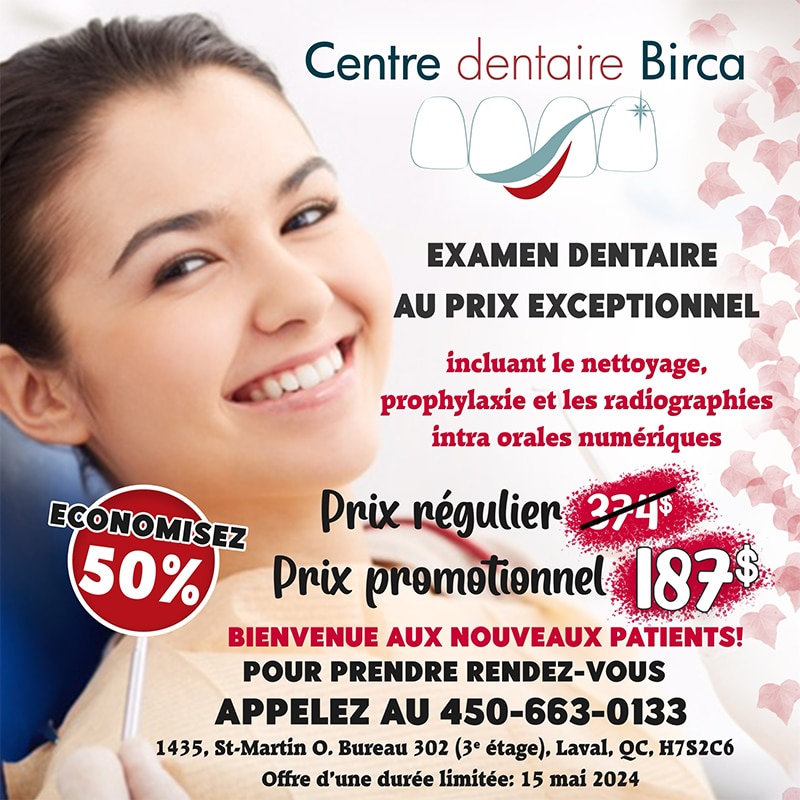General Dentistry
General Dentistry in Laval
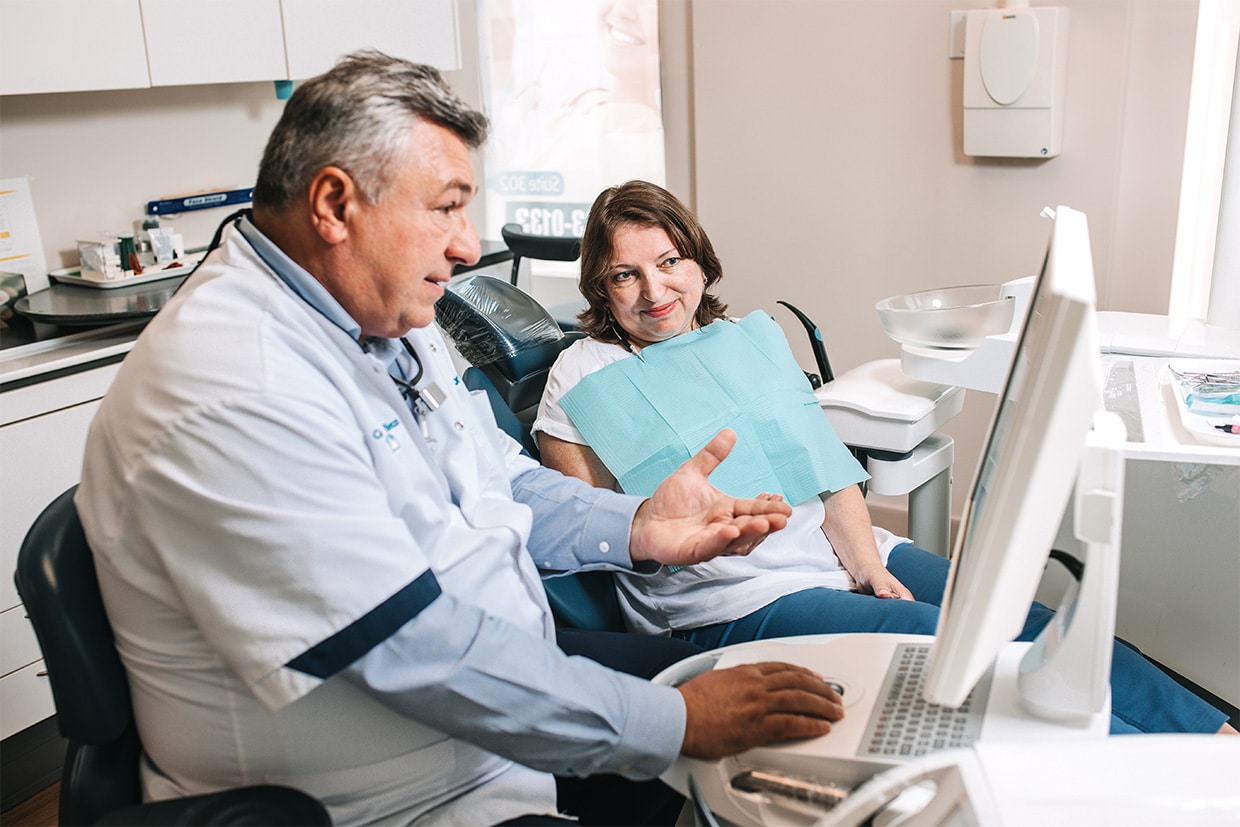
Oral health is paramount and often reflects the general health of a person. The mouth is a point of entry for various types of bacteria into the body : certain bacteria may cause periodontal damage and then continue onto the blood circulation and cause infections. The influence that oral health has on general health is significant.
Dental-related diseases such as dental caries (cavities), pulpitis, endodontic or periodontal abscesses, etc. harm patients’ general health. Some may also have a negative psychological effect or have a negative social impact on the patient’s life. For example : halitosis (bad breath), tooth loss, unstable or displeasing prostheses (dentures), speech impediments caused by tooth loss, crooked teeth, abnormalities of occlusion, misshapen or discolored teeth, etc. Nowadays, looking good is essential to have a good esteem, and a healthy smile has a positive impact on your entourage.
We highly encourage you to consult one of our general dentists so that you may be able to prevent dental disease, or even detect the beginning stages of disease so that you may properly control it.
General Dentistry
Prevention
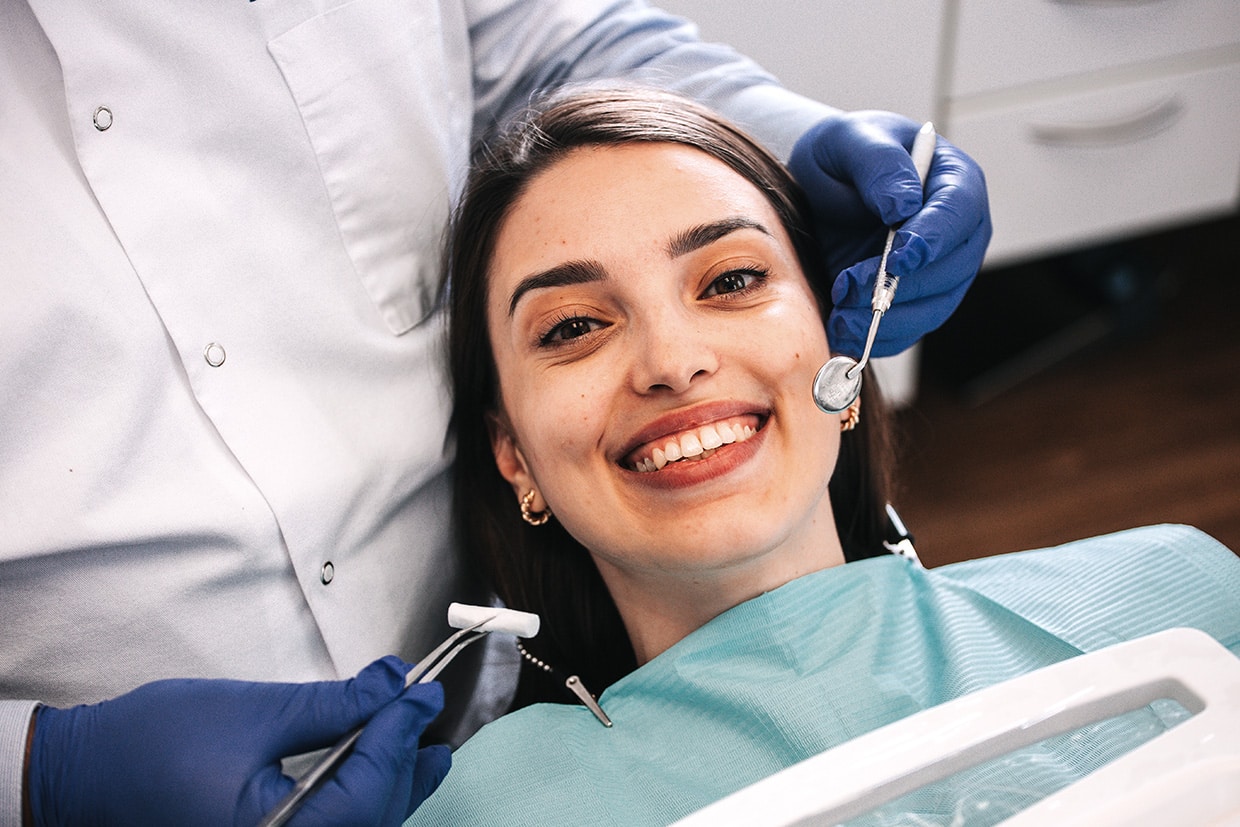
Oral hygiene is the art of taking care of your teeth, gums and tongue. It’s your best ally in maintaining a healthy mouth.
Whether it be for recall exams, dental x-rays, scaling and polishing, or fillings for your cavities, general dentistry provides everything necessary to prevent dental disease, and to maintain healthy teeth and beautiful smile for life.
Fluoride toothpaste, a manual or electric toothbrush, dental floss, and interdental brushes (Proxabrush, Go-between) are all good tools to help maintain a clean and healthy smile.
We recommend brushing twice daily : once in the morning and again at night before bedtime. Tooth brushing allows you to eliminate plaque thus reducing calculus (tartar) build-up above and below your gums. Failure to do so may result in gingivitis, periodontal disease, and dental caries (cavities).
It is important to pay close attention when brushing, in order to eliminate all food residues and plaque that have been built up on your teeth. Don’t forget your tongue : dead cells may accumulate here and contribute to halitosis (bad breath). Try using a tongue scraper to remove bacteria and dead cells that may build up in this area.
It’s important to see a dentist once every 6 months for early detection of decay and malocclusions. Hygiene recall frequency is determined by the patient’s hygiene and susceptibility to tartar build-up. Some may experience tartar build-up more quickly than others, and those people have a higher risk of developing periodontal disease. Patients with periodontal disease are seen in our office every 3 months rather than every 6 months.
In younger patients, their adult teeth have not yet completely mineralized and are at a higher risk for decay. To help with this problem we perform topical fluoride applications on our younger patients.
The deep, non-smooth areas on the biting surface of teeth are referred to as pits and fissures. These areas are where decay tends to arise and to prevent that, we recommend placing sealants, which may reduce caries in this area by up to 90%.
General Dentistry
Operative dentistry

Operative dentistry, or restorative dentistry is the art of restoring teeth that are damaged by decay, trauma, erosion, attrition, abfraction, grinding or excessive wear.
Dental caries is an infectious disease. It is caused by sugars found in our diet mixed with the actions of bacteria present in our mouth. Bacteria found in dental plaque destroy first, the enamel, then the dentin of our teeth.
Attrition is when there is wear and a loss of enamel on teeth due to abnormal and repeated grinding (bruxism), or from excessive pressure on teeth. The teeth are crushed by a repeated traumatic action.
Erosion of teeth happens when teeth are in contact with acidic foods or acid from the gastrointestinal tract. Erosion is irreversible and causes permanent damage to enamel. The enamel slowly becomes softened and then becomes susceptible to further wear from brushing or from mastication.
Some people grind their teeth at nighttime, and the forces generated are tremendous. This causes severe abrasion of tooth structure. Generally, affected teeth are restored with composite, porcelain restorations, amalgam, or indirect gold restorations.
General Dentistry
Cosmetic dentistry

Cosmetic dentistry is used to correct imperfections and/or abnormalities of tooth colour and structure.
For example, to correct a small chip on a tooth, to fill a diastema (a space in between teeth), to straighten teeth, or to change the shape or colour of one or multiple malformed teeth due to fluorosis, osteogenesis imperfecta, or tetracylin. One way of doing this is with porcelain veneers – a conservative preparation of the facial surface of the tooth is performed in order to accommodate the veneer.
The classic veneer is an indirect restoration made with porcelain. Also available is a chair-side direct composite veneer. Another example of cosmetic dentistry is tooth bleaching (whitening) which may be of service for patients who are unsatisfied with the shade of their teeth.
Veneers are not always possible however. Sometimes if there is a malocclusion, or a heavily restored tooth, a crown would be indicated. This treatment is a little more complex, since the entire circumference of the tooth needs to be prepared. The tooth is then covered up with a durable ceramic cap.
General Dentistry
Extractions
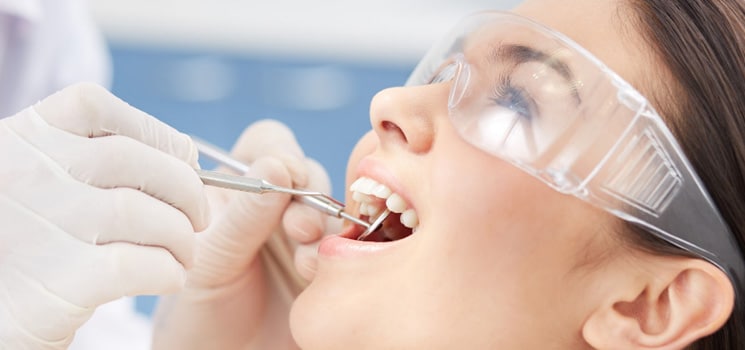
When a tooth is non-restorable, it is necessary to extract it. There are quite a few situations that may lead to this such as: extensive decay, coronal or root fracture, a considerable periapical abscess, periodontal abscess, considerable tooth mobility, etc.
Primary teeth need not be replaced after an extraction, nor do wisdom teeth. In all other cases, the tooth requires a replacement of some sort because the dental arch becomes asymmetric and less resistant to the forces of mastication. Adjacent teeth may drift and loss bone support. The ability to masticate properly diminishes as well. Loss of anterior teeth becomes a cosmetic issue.
There are 3 options to replace missing teeth: dental implants, bridges, or removable prosthesis. Implant placement requires specific circumstances and may not be done in every case. One condition is sufficient bone volume.
After a tooth is extracted, vertical and horizontal bone loss of up to 40-50% occurs. In fact, it’s the root that maintains bone height. The teeth’s roots are anchored in the jaws and offer a stable base to teeth. When a tooth is extracted, the roots no longer stimulate bone in this area during mastication, and the bone begins to deteriorate. When a patient loses all of their teeth, this considerably accelerates bone resorption in both the upper (maxilla) and lower (mandible) jaws.
When placing implants, it is imperative to have an implant that is long enough and wide enough. To do so requires good bone quality.
Sometimes, bone must be added through a bone graft. A better result is obtained if the graft is placed at the moment of extraction. This allows socket (and bone) conservation.
In order to replace one or many missing lower teeth where there’s not a possibility of doing a bridge, we use removable partial dentures (RPDs). We call these cases “distal extensions”. These distal extension RPDs are not tooth borne and are only supported by gums and underlying bone of the edentulous ridge. They will lack stability and also contribute to bone resorption. Poor retention and inadequate mastication are often associated to this type of RPD. They are often uncomfortable because they are massive, as well as unstable during mastication and elocution (speaking). Bone resorption is even more considerable when we’re talking about a complete denture due to the increased pressure on the gums and mucosa and their underlying bone. With this being said, implants are the best solution to this and the best way to restore the edentulous ridge.
Limited bone has already been discussed as a contra-indication. Other contra-indications to dental implants may include high blood sugar, immune problems, poor oral hygiene, high cholesterol and smoking.
In order to properly evaluate whether dental implants are right for you, a 3D scan, also known as a CBCT is necessary. Prior to the implant surgery, models of your jaws and a surgical guide are made. From a physiological point of view, implants are the best solution because not only does this biocompatible material provide a firm anchorage in your jawbones, but it also prevents future resorption of your alveolar ridge.
If you have missing teeth or uncomfortable prosthesis (dentures), we encourage you to make an appointment for a consultation so that we may propose you the best treatment for you.
General Dentistry
Periodontal surgery
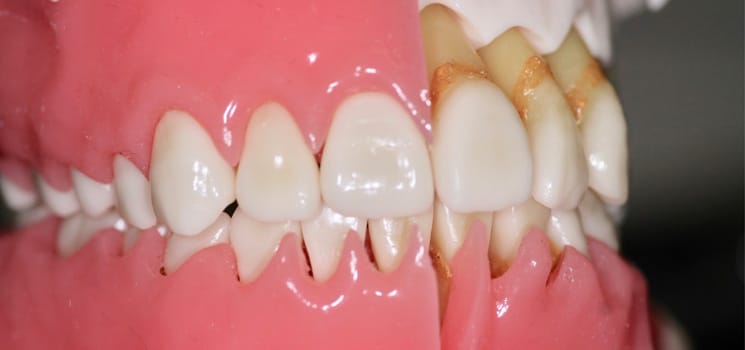
At Centre dentaire Birca, we offer free gingival grafts (FGG), connective tissue grafts (CTG), or Alloderm tissue grafts to either cover recession or to protect teeth from further recession.
General Dentistry
Endodontics

Endodontics includes root canal treatments and the retreatment of previously treated teeth. A root canal treatment (RCT) is necessary when the nerve of the tooth is exposed by caries or fracture, or otherwise an abscess may develop.
During a root canal treatment, an access to the nerve is drilled, the nerve is removed, the canals are cleaned and shaped, and are then filled with a biocompatible material. After the RCT is completed, we recommend placing a crown on the tooth in order to protect it from fracturing.
There are various causes of an infected dental nerve. Likewise, there are various symptoms that may be associated with this. These may include: sharp nocturnal pain, throbbing pain, or sensitivity to hot foods, cold foods, biting or even to touch. When the pulp of the tooth presents irreparable damage, RCT is indicated. Sometimes this happens and there is an absence of pain. One way to diagnose this is with X-rays. An asymptomatic tooth is not always a healthy tooth. Early detection is important in order to save the tooth.
Frequently, caries may recur underneath old restorations. If this decay becomes sufficient deep and lies in close proximity to the nerve, there is a high risk that the bacteria may have reached this area. Often this is a painless, but latent infection.
Dr Birca has been passionate about endodontics (as well as orthodontics and periodontics) for a long time.
General Dentistry
Prosthodontics
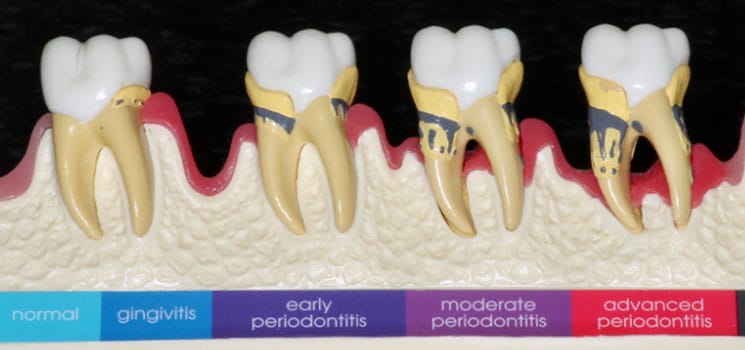
Prosthodontics is the branch of dentistry that deals with replacing missing teeth with dental prostheses. Fixed prosthodontics options include: veneers, crowns, bridges, implants, or screw-retained implant-supported dentures.
Certain situations require removable prosthodontics. These options include: complete dentures, removable partial dentures, or implant-supported removable dentures.
General Dentistry
Orthognathic surgery

Orthognathic surgeries, as well as cyst and tumor removal are only practiced in either hospitals or in a specialist’s office. This specialist is commonly referred to as an oral surgeon, or an oral and maxillofacial surgeon (OMFS).

